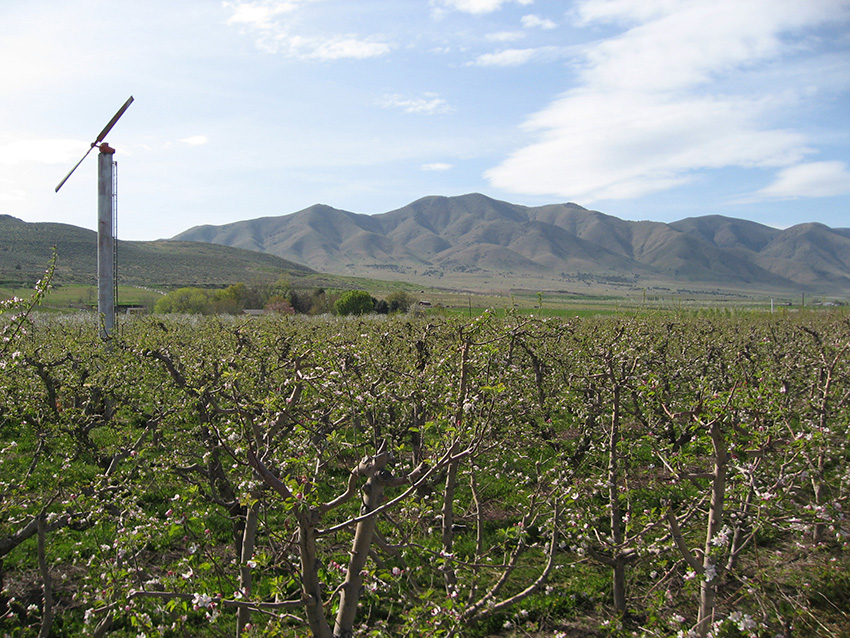
Temperatures are expected to drop below freezing in many parts of Utah on Tuesday and Wednesday mornings. Researchers have tested fruit flowers in various stages of growth and determined the coldest temperatures that would kill 10% of the flowers and 90%, abbreviated as the T10 and T90. As an example, many peach trees in central and northern Utah are in full bloom. If the temperature drops to 27°F for just 30 minutes, potentially 10% of the flowers can be killed and if the temperature drops to 24°F, 90% of the flowers can be killed. Keep in mind that fruit trees produce more flowers than are needed for a good crop harvest.

Please refer to this fact sheet, “Critical Temperatures for Frost Damage” and review the pictures of crop stages and temperatures to determine if your own trees are at risk. As you watch your local forecast, note that weather stations that report temperatures might be warmer or colder than your area. No frost protection scheme will be perfect, and the costs range from minimal to the extreme.
Cloth Coverings

This option is useful to protect a small number of trees; it is not practical for an orchard or for very tall trees. Light sheets, burlap, or frost blankets can provide some protection. Do not use plastic tarps because plastic isn’t a good insulator, and tissues touching the plastic may still freeze. Apply the cloth during the day to trap existing warmth. Keep in mind that draping the cover over the tree will usually require more than one person (and some patience). Make sure it is large enough to reach the ground so that it retains all the warmth under the cloth. You may need stakes depending on the shape of the tree. Also, irrigate the ground under the trees beforehand, as the wet soil will absorb heat during the day. Don’t remove the cloth until late in the morning the next day.
Water
According to research, overhead irrigation can increase temperatures by 4-6 degrees, and under-tree irrigation by 1-3 degrees. Using water is one of the cheapest options, where it is available. The downside of using water is over-saturating the soil, leaching of nutrients, runoff, and water-use restrictions. The irrigation must continue until any ice that has formed melts, which could be many hours.
Orchard Heater
Heaters can help to gain around 1-3 degrees in an orchard. This is one of the most expensive and least efficient options. In a larger orchard, they require lots of fuel and labor. About 40 to 60 heaters are needed per acre, each using about 1 gal of fuel per hour. Only about 10-15% of the heat actually stays in the orchard; the rest is dissipated. Heaters are best used in conjunction with wind machines.
Wind Machines or Helicopters

These devices mix warm air from above with cold air at tree level, and can help to gain around 1-4 degrees in an orchard. A wind machine covers about 10 acres, while a helicopter, although more expensive ($700- $2,000 per hour), can protect 40 acres, and can bring warm air down from higher levels.
Frost Rescue Spray on Apples
A material called Promalin (a plant growth regulator from Valent) can be used within 24 hours of a bloom-time freeze on apples to promote fruit-set from damaged flower tissue that would not otherwise survive. The product contains plant growth hormones (gibberellic acids and cytokinin) that promote cellular division in plant tissues, leading to greater survival of freeze-damaged blossoms. It has been tested in other states (NY, NC, MI) with varying results. In North Carolina, it was applied within 5 hours of a T90 frost event on apples. The treated orchard had a 25% crop while the untreated orchard was entirely lost (a savings of $2,400/acre). In Michigan however, Promalin did not significantly save crops from damage versus untreated crops of Idared, Rome, SweeTango, or Red Delicious varieties. Surviving Promalin-treated apples grow to a normal size, but tend to be seedless. Questions remain about the efficacy of Promalin under varying conditions, how long after a freeze it can be applied, and the problems of storing fruit without seeds.
